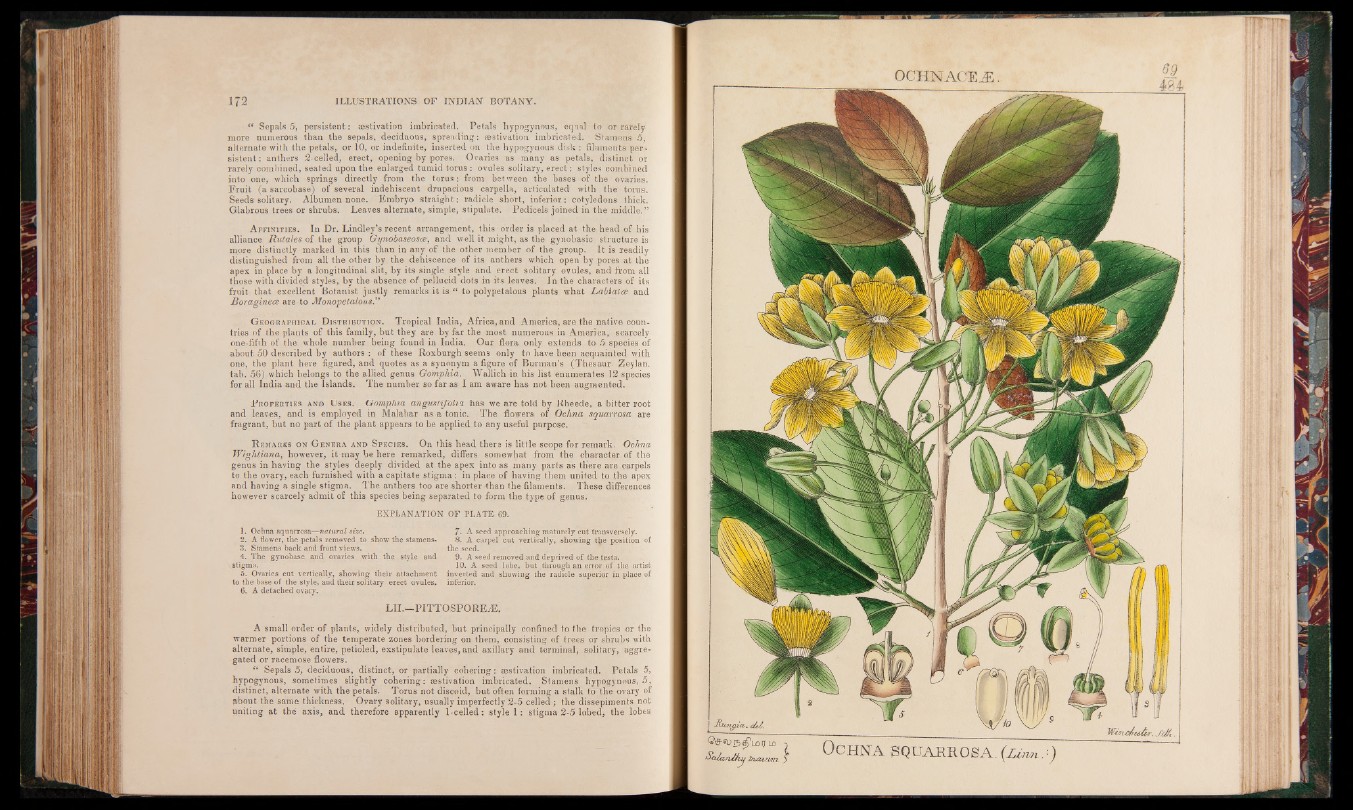
te Sepals 5, persistent: aestivation imbricated. Petals hypogynous, equal to or rarely
more numerous than the sepals, deciduous, spreading: aestivation imbricated. Stamens 5,
alternate with the petals, or 10, or indefinite, inserted on the hypogynous disk : filaments persistent
: anthers 2-celled, erect, opening by pores. Ovaries as many as petals, distinct or
rarely combined, seated upon the enlarged tumid torus : ovules solitary, erect: styles combined
into one, which springs directly from the torus: from between the bases of the ovaries.
Fruit (a sarcobase) of several indehiscent drupacious carpella, articulated with the torus.
Seeds solitary. Albumen none. 'Embryo straight: radicle short, inferior: cotyledons thick.
Glabrous trees or shrubs. Leaves alternate, simple, stipulate. Pedicels joined in the middle.”
A f f in i t i e s . In Dr. Lindley’s recent arrangement, this order is placed at the head of his
alliance Rutales of the group Gynobaseosce, and well it might, as the gynobasic structure is
more distinctly marked in this than in any of the other member of the group. It is readily
distinguished from all the other by the dehiscence of its anthers which open by pores at the
apex in place by a longitudinal slit, by its single style and erect solitary ovules, and from all
those with divided styles, by the absence of pellucid dots in its leaves. In the characters of its
fruit that excellent Botanist justly remarks it is “ to polypetalous plants what Labiates and
Boraginece are to Monapetalous.” .
G e o g r a p h ic a l Distribution. Tropical India, Africa, and America, are the native countries
of the plants of this family, but they are by far the most numerous in America, scarcely
one-fifth of the whole number being found in India. Our flora only extends to 5 species of
about 50 described by authors : of these Roxburgh seems only to have been acquainted with
one, the plant here figured, and quotes as a synonym a figure of Barman’s (Thesaur- Zeylan.
tab. 56) which belongs to the allied genus Gomphia. Wallich in his list enumerates 12 species
for all India and the Islands. The number so far as I am aware has not been augmented.
P r o p e r t ie s a n d U s e s . Gomphia angustifolia has we are told by Rheede, a bitter root
and leaves, and is employed in Malabar as a tonic. The flowers of Ochna squarrosa are
fragrant, but no part of the plant appears to be appliecLto any useful purpose.
R em a r k s o n G e n e r a a n d S p e c i e s . On this head there is little scope for remark, Ochna
Wightiana, however, it may be here remarked, differs somewhat from the character of the
genus in having the styles deeply divided at the apex into as many parts as there are carpels
to the ovary, each furnished with a capitate stigma: in place of having them united to the apex
and having a single stigma. The anthers too are shorter than the filaments. These differences
however scarcely admit of this species being separated to form the type of genus.
EXPLANATION OF PLATE 69.
1. Ochna squarrosa—natural size.
2. A flower, the petals removed to show the stamens-
3. Stamens back and front views.
4. The gynobase and ovaries with the style and
stigma.
5. Ovaries cut vertically, showing their attachment
to the base of the style, and their solitary erect ovules.
6. A detached ovary.
7- A seed approaching maturely cut transversely.
8. A carpel cut vertically, showing ttye position of
the seed.
9. A seed removed and deprived of the testa.
10. A seed lobe, but through an error of the artist,
inverted and showing the radicle superior in place of
inferior.
LU.—PITTOSPOREÆ.
A small order of plants, widely distributed, but principally confined to the tropics or the
warmer portions of the temperate zones bordering on them, consisting of trees or shrubs with
alternate, simple, entire, petioled, exstipulate leaves, and axillary and terminal, solitary, aggregated
or racemose flowers.
“ Sepals 5, deciduous, distinct, or partially cohering: aestivation imbricated. Petals 5,
hypogynous, sometimes slightly cohering: aestivation imbricated. Stamens hypogynous, 5,
distinct, alternate with the petals. Torus not discoid, but often forming a stalk tcTthe ovary of
about the same thickness. Ovary solitary, usually imperfectly 2-5 celled; the dissepiments not
uniting at thé axis, and therefore apparently 1-celled: style 1: stigma 2-5 lobed, the lobes,
OCHNACEÆ. 61
484
■Rlvtuplcb. cbl.
Q<&-$o j5f£Yoij Lo
^ctlccJlMby iru tu w v |